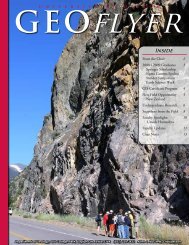Stander Symposium abstract book - University of Dayton
Stander Symposium abstract book - University of Dayton
Stander Symposium abstract book - University of Dayton
Create successful ePaper yourself
Turn your PDF publications into a flip-book with our unique Google optimized e-Paper software.
9:00 AM to 10:30 AM<br />
are not affected by rain. When this method is used in conjunction with phase correlation, we are able to remove rain <strong>of</strong> medium density from<br />
videos even when complex camera movement is involved. By making the selection <strong>of</strong> candidate rain pixels in an adaptive manner, we were able<br />
to remove rain when moving objects are present in the scene. However, the movement is causing some noise along the edges in the resultant<br />
videos. We are in the process <strong>of</strong> devising a method to remove that noise. By excluding the directional property <strong>of</strong> rain streaks and including some<br />
constraints related to intensity, we were able to adapt the algorithm to removing snow from videos as well. However, the results are noisy and<br />
research is in progress to make the algorithm more effective in such scenarios.<br />
Position-Adaptive Direction Finding for Multi-Platform RF Emitter Localization<br />
Presenter(s): Huthaifa A Alissa<br />
Advisor(s): Raul E Ordonez<br />
Electrical and Computer Engineering - Graduate Research<br />
Wireless Sensor Networks (WSNs) are being used in a variety <strong>of</strong> ways from reconnaissance and detection in military to biomedical applications<br />
and a wide variety <strong>of</strong> commercial endeavors. In recent years, position based services have become more important. Thus, recent developments<br />
in communications and RF technology have enabledsystem concept formulations and designs for low-cost radar systems using state-<strong>of</strong>-the-art<br />
s<strong>of</strong>tware radio modules. This research focuses on a multi-platform RF emitter localization technique denoted as Position-Adaptive RF Direction<br />
Finding (PADF). PADF is based on the formulation and investigation <strong>of</strong> path-loss based RF scattering metrics (i.e., estimation <strong>of</strong> distributed Path<br />
Loss Exponent, or PLE) that are measured and estimated across multiple platforms in order to enable the robotic/intelligent position-adaptation<br />
(or self-adjustment) <strong>of</strong> the location <strong>of</strong> each platform. Experiments conducted at the Air-Force Research laboratory (AFRL) indicate that this position-adaptive<br />
approach exhibits potential for accurate emitter localization in challenging embedded multi-path environments such as in urban<br />
environments. In this study we use IRIS wireless sensor nodes. In order to localize the transmitter, we use the Received Signal Strength Indicator<br />
(RSSI) data to approximate distance from the transmitter to the revolving receivers. We provide an algorithm for online estimation <strong>of</strong> the Path Loss<br />
Exponent (PLE) that is used in modeling the distance based on Received Signal Strength (RSS) measurements. The emitter position estimation is<br />
calculated based on surrounding sensors RSS values using Least-Square Estimation (LSE). PADF configuration concepts are developed for purposes<br />
<strong>of</strong> investigating potential refinements in consistency, sensitivity, and robustness via the design and implementation <strong>of</strong> four stationary sensors as<br />
receivers and one hidden sensor as a transmitter during the localization phase.<br />
Real Time Path Planning <strong>of</strong> Industrial Robots in an Unknown Environment Using Vision<br />
Presenter(s): Hariharan Ananthanarayanan<br />
Advisor(s): Raul E Ordonez<br />
Electrical and Computer Engineering - Graduate Research<br />
Industrial manipulators are machines that perform pre-programmed tasks with great accuracy and speed. The addition <strong>of</strong> intelligence through<br />
sensory perceptions would make them highly flexible in terms <strong>of</strong> performance and application. The objective <strong>of</strong> this research is to improve the<br />
performance <strong>of</strong> a six-degree <strong>of</strong> freedom industrial manipulator by introducing vision feedback and by using the data to generate its path in real<br />
time. This would enable the robot to generate its own path and alter it dynamically, based on the visual feedback. This technique will be finally<br />
used to catch a ball or pick a ball rolling on the floor. One <strong>of</strong> the industrial applications could be robotic recycling where a robot is required to pick<br />
up different objects from a moving conveyor.<br />
X-band Miniaturized Coplanar Waveguide Band-pass filter with Coupled Resonator<br />
Presenter(s): Chenhao Zhang<br />
Advisor(s): Guru Subramanyam<br />
Electrical and Computer Engineering - Graduate Research<br />
Band-pass filter is the basic component in microwave/RF integrated circuit. It plays the extremelyimportant role in communication systems such<br />
as wireless, radar and GPS navigation systems. Thisproject develops a passive narrowband band-pass filter which works in X-band spectrum<br />
(8GHz-12GHz).The filter is fabricated on a 400µm thickness sapphire substrate with a 0.25µm thickness BST thin filmdeposited using a large<br />
area pulsed laser deposition system. Compared with traditional microstripfilters, it has miniaturized dimensions and good frequency tunability.<br />
68

















